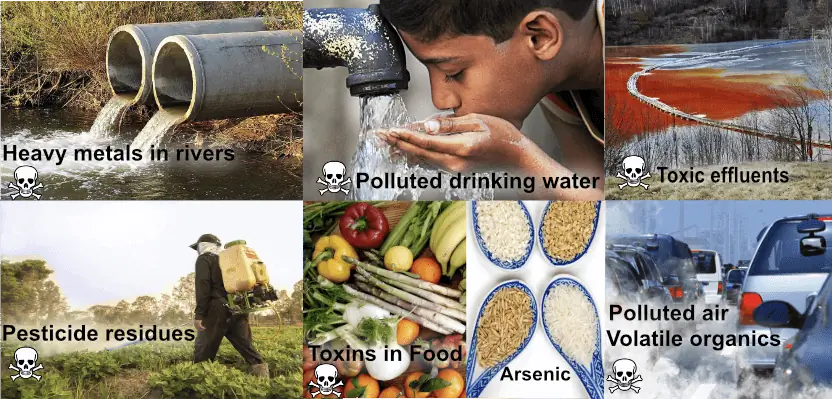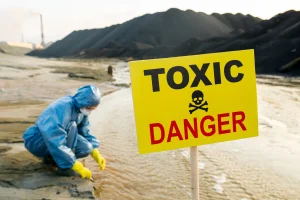Heavy metals can exist as toxic species which are found in many everyday retail products. This exposure represents a public health risk.
Heavy metals are a natural part of the Earth’s surface and thus are present almost everywhere in various forms and concentrations. They can be found in rocks, soils, sediments, water and air.
Heavy metals, such as arsenic, chromium, lead and mercury, occur as many different species (see our article on ‘Chemical Speciation’ for more detail). These species cause a wide range of toxic biochemical effects and therefore represent a high risk for human health and the environment.
Traces of toxic heavy metals are found in products as basic as rice, milk and vegetables. To keep our food supply safe, regulatory bodies need to monitor and test foodstuff and set national and international standards and safe levels for metals. It is also vital to monitor the cycling, distribution and accumulation of heavy metals in the environment in order to reduce their adverse impacts.
Impact on Health
Toxic heavy metals pose risks to our health if they enter the body through inhalation, digestion or skin absorption. Once inside of us, these elements will accumulate in cells and tissues, potentially damaging biomolecules and adversely affecting the function of our vital organs.
Toxic heavy metals can damage our bodies in various ways. Depending on the area affected, they can cause one of three types of toxicity:
-
Central Nervous System Toxicity. Heavy metals can disrupt the nervous system, damaging the constituents of our blood and vital organs and causing mental disorders.
-
Neurological Toxicity. An accumulation of these metals can lead to impairment of muscular and neurological processes, resulting in effects similar to those of Parkinson’s or Alzheimer’s diseases.
-
Carcinogenic Toxicity. Chronic exposure to some heavy metals can cause biomolecule mutation, leading to cancerous growth.
Occurance of Heavy Metals
The spread of heavy metals occurs in two main ways: via natural processes such as volcanic eruptions, weathering/erosion and bacterial activity or via anthropogenic (human) activity. Dangerous concentrations of heavy metals are often a result of the latter.
Heavy metals are obtained by mining rocks for a variety of industrial uses such as leather tanning and corrosion prevention. After they have been used, the metals often end up in wastewater, contaminating effluents and eventually ecosystems if not properly regulated. Heavy metals can also be used to create products such as pesticides, dyes, cosmetics and even children’s toys. The sale of these products increases distribution of heavy metals and our potential toxic exposure to them.
Heavy Metals in the Kitchen: Arsenic in Rice
We don’t need to go far to find potentially toxic heavy metals in everyday products.
For example, the presence of arsenic in rice is a major public health concern. Infants are particularly vulnerable; their young, developing organs and tissues are susceptible to disturbed cellular functioning, and toxic elements are removed more slowly from their bodies than adult ones. Furthermore, rice is a common food choice for young children because it is palatable and has a low risk of causing allergies. , This further compounds their risk of arsenic poisoning.
To mitigate this risk, it is important to understand how arsenic gets in the rice in the first place. Flooded soils where rice commonly grows are usually irrigated by shallow tube wells that can contain groundwater polluted with arsenic. The flooded conditions favour a highly toxic inorganic species containing As(III) (i.e. arsenous acid) which can easily be absorbed by the crops . This leads to the rice being contaminated.
Arsenic ends up in groundwater in several ways. It can occur by the weathering of volcanic rocks or alluvial/deltaic sediments which posses high natural concentrations of the element and are transported into the groundwater; this is a prevalent phenomenon in Bangladesh. In the US, the use of pesticides containing inorganic arsenic led to the contamination of groundwater up until the 1980’s when many of these pesticides were banned. In New Jersey, for example, 6.8 million kg of arsenic was released into soil/water systems between 1900 and 1980 via pesticides for crops. Unregulated mining of arsenic-rich materials can also lead to arsenic pollution of groundwater, something which has occurred in the ‘Iron Quadrangle’ in Minas Gerais, Brazil, one of the world’s biggest mineral provinces. Mining has been taking place there for over 300 years.
In the UK, rice used to produce food for infants is allowed to contain inorganic arsenic concentration of less than 0.1 milligrams per kilogram (mg/kg) in alignment with European Commission regulations. A recent study (Menon et al, 2020) showed that out of 55 commercially available rice grains, 28 exceeded this limit. This prevalence of contaminated rice highlights the need for consumption warnings and for proper testing and monitoring of heavy metal species in food.
The presence of toxic heavy metals in the products we consume is an immediate public health risk. Nanolyse Technologies Ltd is working towards developing simple analytical tools for testing and monitoring heavy metals in foodstuff and beverages.
Please cite this article as: “Matt Randall, Bàrbara Levering and Juliet Martin (2020), Toxic heavy metals in everyday products: a public health risk. Nanolyse Technologies, Oxford, UK.”
Further Reading
- Biswas, J. K., Warke, M., Datta, R., & Sarkar, D. (2020). Is Arsenic in Rice a Major Human Health Concern? Current Pollution Reports, 6, 37–42. https://doi.org/10.1007/s40726-020-00148-2
- Engwa, G. A., Ferdinand, P. U., Nwalo, F. N., & Unachukwu, M. N. (2019). Mechanism and Health Effects of Heavy Metal Toxicity in Humans. In O. Karcioglu & B. Arslan (Eds.), Poisoning in the Modern World – New Tricks for an Old Dog? (pp. 1–23). IntechOpen. https://doi.org/10.5772/intechopen.82511
- Menon, M., Sarkar, B., Young, S., Hufton, J., Reynolds, C., & Reina, S. V. (2020). Do arsenic levels in rice pose a health risk to the UK population? Ecotoxicology and Environmental Safety, 197(January), 110601. https://doi.org/10.1016/j.ecoenv.2020.110601
- Sarkar, D., Datta, R., & Sharma, S. (2005). Fate and bioavailability of arsenic in Part-I : incubation study. Chemosphere, 60, 188–195. https://doi.org/10.1016/j.chemosphere.2004.11.060
- Texeira, M. C., Santos, A. C., Fernandes, C. S., & Ng, J. C. (2020). Arsenic contamination assessment in Brazil – Past , present and future concerns : A historical and critical review. Science of the Total Environment, 730, 1–21. https://doi.org/10.1016/j.scitotenv.2020.138217




